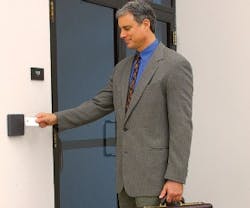From Keys to Cards
While traditional mechanical locking hardware provides a high level of security, it’s not always cost effective or efficient. If tenants or employees leave, locks have to be re-keyed, and new keys must be distributed. (A locksmith can charge up to $250 to rekey a double door and provide 50 replacement keys.)
One of the biggest benefits to electronic access control? It mitigates the need for keys. Common systems consist of a computer, access control system software, and a database program to manage badges and authorizations. The computer connects to data-gathering panels located in telephone rooms or at the door (this connection may be hardwired or routed via an Ethernet network). Each controlled access door is equipped with a card reader, an electric lock, a door position switch, and a request-to-exit device. These devices are wired to the data-gathering panel.
The typical cost to install a card reader on a single door is $3,000 to $5,000, which includes the electric lock, the card reader and associated devices, the percentage of the access control panel, system software, and computer hardware.
An advantage to electronic access control is that doors can be programmed to unlock automatically during business hours, which negates the need for someone to unlock doors at the start of the business day and relock them at the close of business.
In addition to employee badging, many buildings also use the access control system for visitor logging. In the case of a building with a reception desk, the access control system can be used to log visitors by scanning a license or business card and then printing a disposable badge. This type of system eliminates paper sign-in sheets and maintains a simple-to-search log of visitors. It can also be used to alert the receptionist of a visitor who isn’t approved to enter the building.
Electronic access control systems are also commonly used to monitor building doors and other types of alarm inputs, such as power failure, high or low temperature alarms, or water level alarms. Card-reader-controlled doors are installed with a door position switch that sends a signal if the door is unsecure. This can be important not only for security, but for environmental reasons, too. In fact, almost any type of alarm can be monitored by the access control system. Access control systems will allow audible and/or visual signaling devices to be connected to annunciate an alarm condition. Some access control systems even send an e-mail to a security officer or to building management when an alarm is activated.
Electronic access control systems offer many advantages over traditional key-based access control in terms of cost savings, increased security, and convenience, and they can be considered for any security upgrade plan.
Mark S. Bennett is the president of MSB Security Consulting (www.msbsecurityconsulting.com). He can be reached at [email protected].
